2007 VOLKSWAGEN GOLF PLUS warning
[x] Cancel search: warningPage 251 of 541
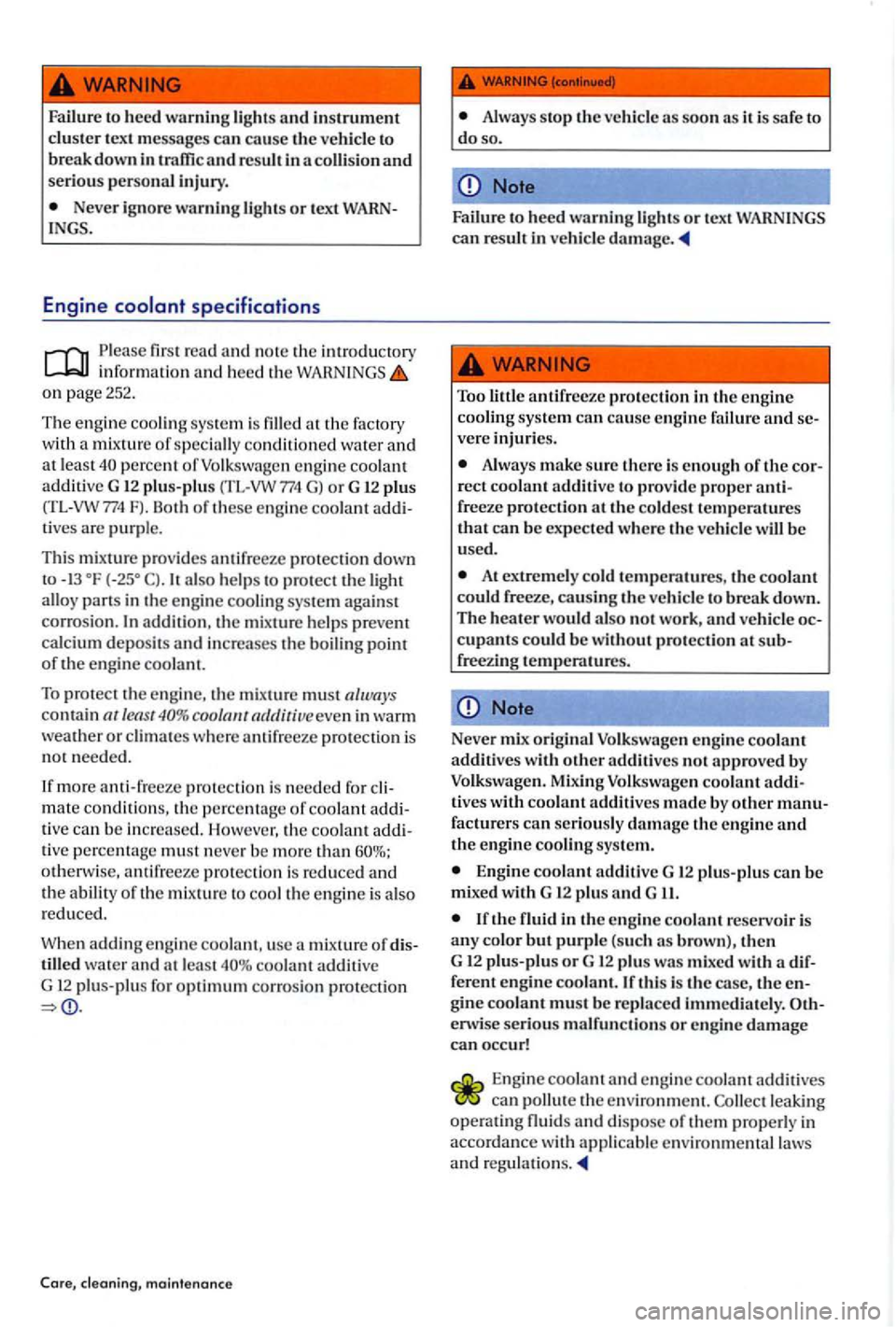
Failure to heed warnin g light s and instrument cluster text message s can cause the ve hicl e to break down in traffic and result in a and seriou s personal injury .
Never ignore warning light s or text I NGS.
Engine coolant specifications
introdu ctory information and heed th e on pag e 252.
The engi ne c ooling sys tem is fille d
p erce nt of Volk s wa gen engi ne coo lant additi ve G 12 plu s-plu s (TL-VW 774 G) o r G 12 plus (TL -VW F). Both of these engin e coola nt ti ve s are purple.
This mixtur e pro vides antif r eeze pro te ction down
to -13 a ls o he lps to pro tec t th e light
allo y pan s in th e eng in e coolin g sys te m against
corro sio n. In addit ion, the mi xture help s preve nt
c alcium dep os its and in creases the bo ilin g point of the e ng in e coola nt.
T o
protec t th e e ng in e, the mi xture must a lway s co nt ain nt le a st
mate conditions , th e perc entage of coola nt ti ve can be in cre ased. Howe ver, the coo la nt ti ve pe rc e n ta ge mu st never be m ore than oth erw ise , ant ifreeze prot ection is reduce d a nd
th e ability of the mi xture to coo l th e e ngine is als o
r educed.
Whe n addin g e ngine coolant, use a mixture of till ed water and at l ea st c o o la nt addit ive G 12 plu s- plu s for optimum co rro sion protection
Core, maintenanc e
Always stop the vehicl e as soon as it is saf e to do so.
Note
Failure to heed warning lights o r text can re s ult in veh icle damage.
Too little antifreeze protection in the en gin e coolin g syste m can cause eng in e failure and vere injuri es.
be used.
At extremely cold temperatures, the coolant could freeze, cau sin g the v ehicl e to brea k down. The heater would als o no t work, and ve hicl e cupants could be without protection at free zing temperatures.
Note
N eve r mix original Volkswagen engine coo lant additives with other additi ve s no t approved by
Volkswagen. Mixing Volkswage n coo la nt
facturers can serio usly damage th e engine and th e engi ne coolin g sys te m .
Eng in e coolant additive G 12 plus-plus can b e
m ixed with G 12 plus and G
If the fluid in th e e ngine coo lant res ervoir is any color but purple (s u ch
this is th e case, the gin e coolant mus t b e r epla ced immedi ate ly . envi se serious m alfun ction s or engine damage can occ ur!
E ng in e coolan t a nd engine c oo lant additi ves can pollute th e environm ent. le akin g opera ting a nd disp ose of th em in
acco rdance with appli cable e nvir o nm ent al la ws
a nd
Page 254 of 541

th is sect io n yo u'll find inform ation on th e low ing:
Warning light . . . . . . . . . . . . . . . . . . . . . . . . . . . . . . . 258
Check ing . . . . . . . . . . 2 59
Charg ing, replacing, disconnect ing
and c o nn ecti ng the ve hicle boHery . . . . . . .. . . . . . . . . . . . . . . . . . . .
you are uncerta in in anyway , have the work do ne an aut ho rized Volk swage n dealer or au th orized
Volkswage n Service Serious personal
tery
Symbol Meaning
Always wear eye protectio n!
B a tt ery
acid is hi ghl y co rro sive. ways wear protective gloves and eye protec tion !
Fire, sparks, op en light and sm okin g
a re pro hibit ed !
W hen a batt ery is c ha rge d, it
Bookle t Warranty and Main tena nce book let
fo r worki ng in th e eng ine page 242
Par ts, acce ssories , repai rs and m odifica tio ns
or the electrical sys te m
in your vehicl e can cause seriou s acid burns,
fir es, explo sion s, o r electri ca l s hock s. Alway s
re ad and heed the followin g and safety preca ution s befor e working on
Before working on the ele ctri cal s ystem, way s switch off the ignition and all ele ctrical
consumers and di sconnect the negative
Alwa ys ke ep children awa y from
Always wear eye prot ection . Never let ballery
ac id or lead particles come int o contact with
your eyes, skin , and clothing .
Sulfuric battery ac id is ve ry corros ive . In
contac t with your skin , it can cause acid burns.
If it to uches your e y es, it can cau se blindn ess.
your hands, your arms, and your face and eye s from spillin g or squirtin g acid. To reduce your risk of injury , n eve r tilt the batteri es ,
as thi s could acid throu gh th e vents and burn you.
batterie s from the
v e hicle electri cal sys tem, always disconnect the negative cable H fir st and then the positive cable(+ ).
Always swit ch ofT electri cal con sumers for e reconnec tin g th e batt eri es. Reconnect the plu s cabl e(+) first and then th e nega tive cable().Neve r rev erse the pol arity of the connection s.
Thi s could cause a fire.
A highly explos iv e mixture of ga ses is give n
ofT wh en th e battery is be in g c harged.
D o no t s moke and avoid fires, sparks , and open names when wo rkin g. Never create sparks or ele ctros tati c charges when handlin g ca ble s and elec trica l equipm ent. Nev er short cir cuit the b att ery te rminal s. Hig h -energy s parks can
ca use seriou s pers on al injury.
256 257
Page 255 of 541
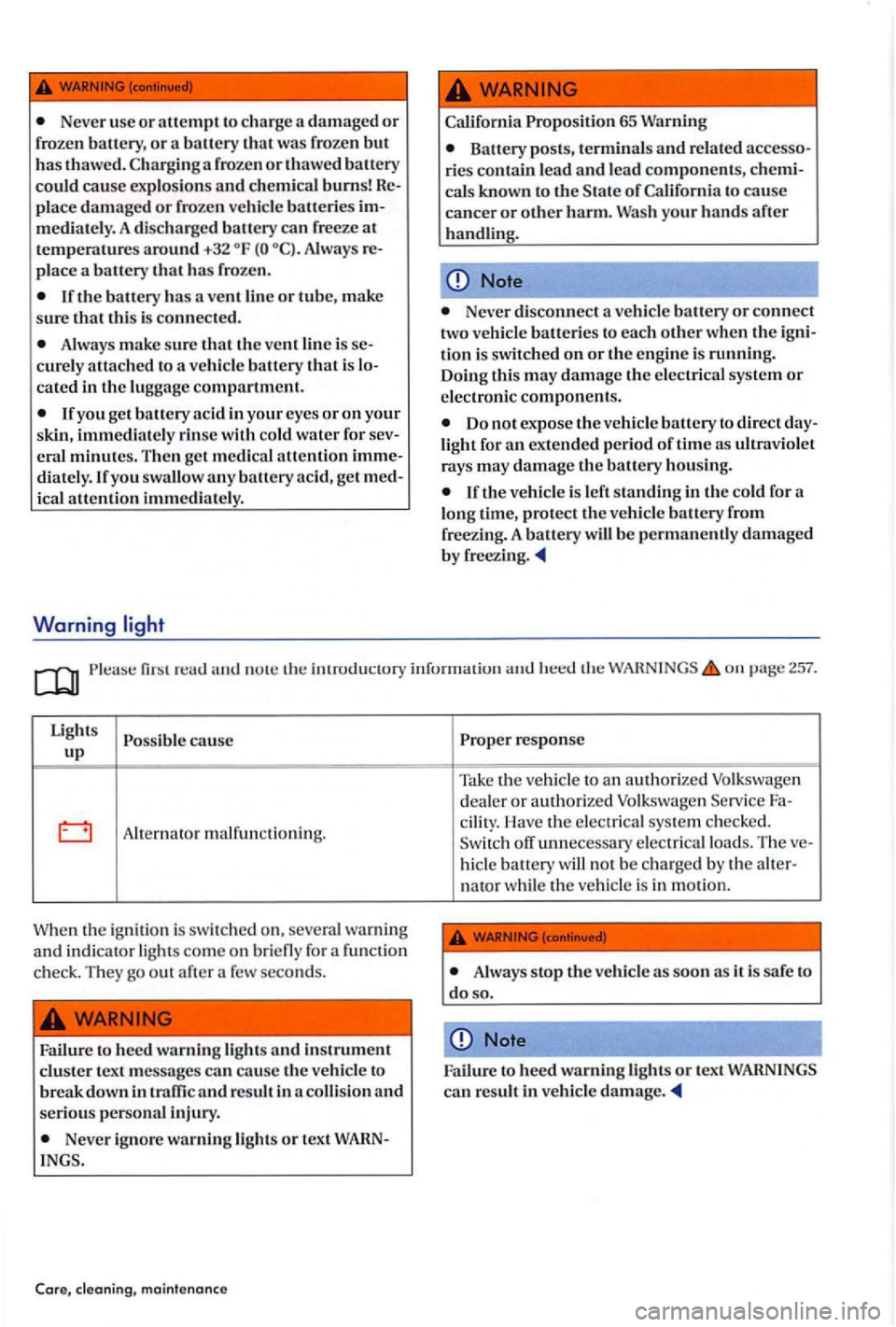
Never use or attempt to ch arge a damaged or frozen battery, or a battery was frozen but has thawed. a frozen or thawed battery could cause explosion s and ch emi cal burns! place damaged or froze n ba tt eri es m ediat ely. A disc harge d battery can freeze at
temperatures around +32 Alway s
the battery has a ve nt lin e or tube, make sure thi s is connec te d.
Always make sure that the vent line is curely attached to a cated in the
If you battery acid in your eyes or on your
eral minutes. The n medical attention
ical attention immedia te ly.
Warning
Battery posts, termin als and related rie s contain lead and lea d compon ent s, cals known to the of to cau se
cancer or other h arm . Wash your hand s after
handlin g.
Note
Never di scon nect a ba tt ery or connec t
two b atte ries to each other when th e
Do not expose the battery to dire ct light for an extend ed p eriod of tim e as ultraviolet rays may damage th e battery housing.
is lef t s tanding in the cold for a
lon g tim e, prote ct th e battery from
fr ee zin g. A battery will be permanentl y damaged by fr eez ing.
infunnatiun on pa ge 257 .
Light s cause up
Alternator malfunctio ning.
W he n th e ig niti on i s s witched on. several warning
a nd in dica tor lights come on briefly for a funct ion ch eck. T hey go out aft er a few seco nds.
Failure to hee d warning lights and instrument
Never ignore warning light s or tex t
cleaning, maintenance
to an authorized dea le r or authorized Volksw agen Fa-cilit y. Have e lectrical syste m ch ec ke d . off unnecessary elec trica l load s. Th e ve-battery will not be c ha rged by the alt er-nato r whil e th e is in moti on.
Always stop tl1e
Note
Failure to heed warning lights or te xt
Page 265 of 541
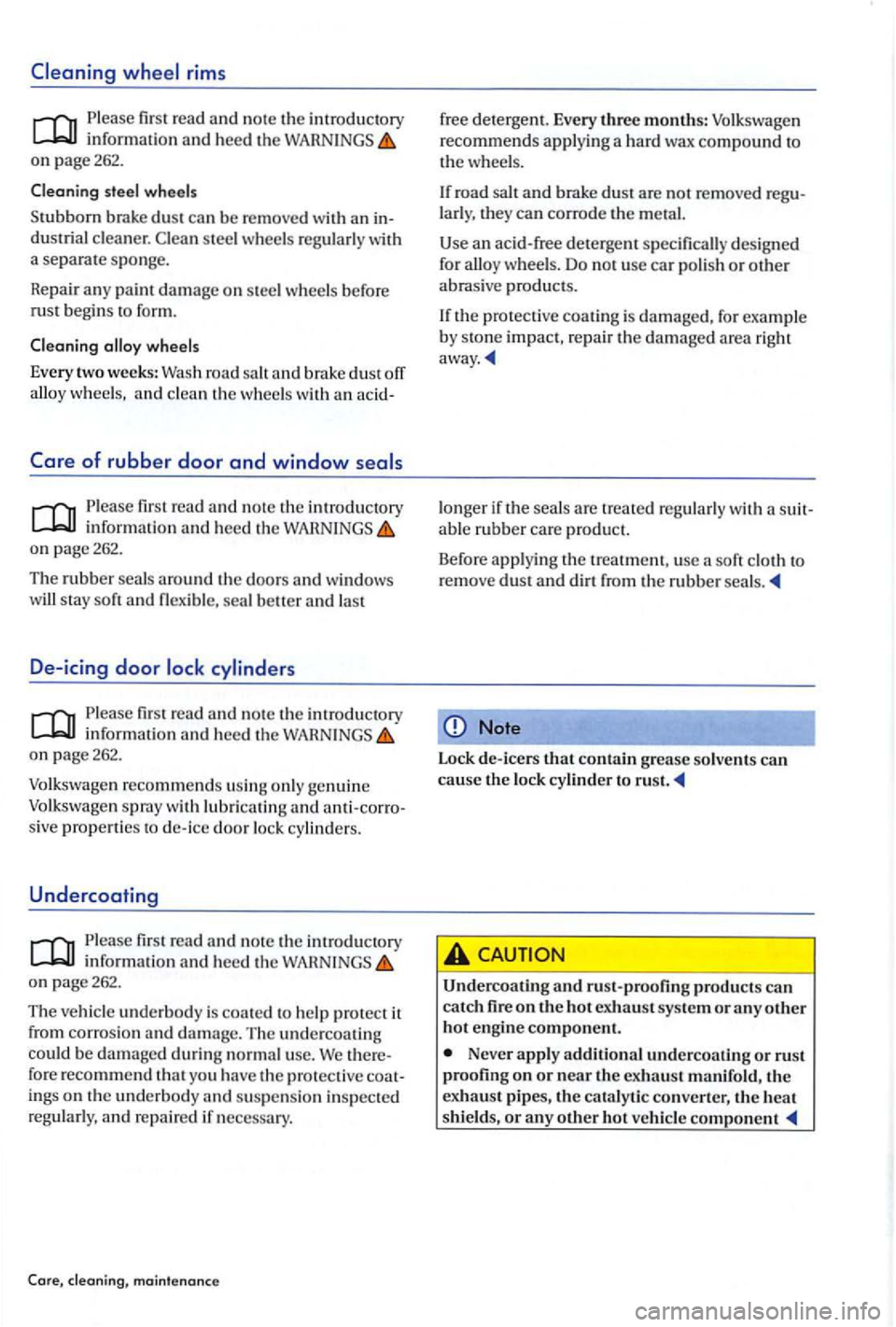
rims
Please fir st read and no te the introducto ry inform atio n and heed the WARN INGS on page 262.
Cleaning
steel wheel s
S
tubborn brake dus t can b e removed an in dustrial clean e r. s teel wheel s regularly with
a se pa rat e s po nge.
Repai r any paint damage o n steel wheels befor e rust begins to fo rm .
Cleaning alloy
wheels
Every two weeks: Wash road salt and brak e dust ofT alloy wheel s, and clean the w heels w ith an ac id-
of rubber door and window
Please information and heed the WARNINGS on p age262.
T he
rubbe r seals around the d oors and w indow s
will s ta y soft a nd flexib le, sea l bett er and la st
De-icing door
Please informatio n and heed th e WARNINGS on page 262.
Volkswage n recommends us in g only genuine Volkswagen spray with lubricating and anti -corro
s iv e pro perti es de-ice door lock cylind ers.
Undercoatin g
Ple ase read and n ot e the introductory heed th e o n page 262.
The ve hicl e underbody is co ated to help protect it
f rom corrosio n and damage. The undercoating could b e damaged durin g normal u se. We there
for e recommend that you have the protectiv e coatin gs on the underbody and su sp e nsion in spected
regularly, and repaired if necessary.
compound to the wheel s.
road and brake dust are not re m ove d regu
larly, they can corrode m etal.
the protective coating is damaged, fo r example
b y s tone impact, repai r the damaged area right
longer if the seals are treat ed regu larly with a suit
able rubbe r care product.
B efor e applyin g the treatment, usc a soft cloth to
r emove dust and dirt from the rubber
Lock de-ic ers that contain grease solvents can cause the lock cylinder to
Undercoating and rust-proofin g products can catch fire on the hot ex h au st sy stem or any othe r
h ot engine componen t.
Neve r apply additional undercoating or rust
proofi ng on or near the ex hau st manifold, the exhaust pipes, catalytic converter, the heat s hields, or any oll 1e r hot vehi cle component
Page 275 of 541

Tire and wheel handling
Fig. 160 Tire rotation diagram.
and note the
mtroductory mformation
and heed the WARNINGS on
page 276.
Tires may be the least appreciated
and most abused parts of a motor
vehicle. Tires are very important,
since their small patches of rubber
are the only contact between your
vehicle and the road.
Maintaining
correct tire pressure,
making sure that your vehicle and
its tires do not have to carry more
weight than they can safe ly
handle, and regularly inspecting
tires for damage (such as cuts,
s la sh es, irregular
wear, and overall
condition) are the
most important
things that you can do to help
avoid
sudden tire failure , in
cluding tread separation and
blowout.
The tires and wheels are essential
parts of the vehicl e's design. The
tires and wheels approved by Yolk-
If you must drive over a curb or
other obstacle, drive very slowly
and as much as possible at a right
angle to
the curb.
Regularly check tires for
damage,
such as punctures, cuts,
tears
and blisters .
Remove embedded material in
the tread profile that has not yet
penetrated the inside of the
page 286.
Heed all warning messages from
the Tir e
Rep lace worn or damaged tires
immediately=> page 286.
Damage to tires and wheels is
often not readily visible. If you no
tice unusual vibration or the ve
hicl e pulls
to one side, this may in
dicate
that one of the tires is dam
aged. The tires must be checked
immediate ly for hidden damage
by an authorized Volkswagen
dealer or an authorized Volk
swagen Service Facility.
Never exceed the load and per
missible maximum speed rating of
the tires=> page
Page 280 of 541
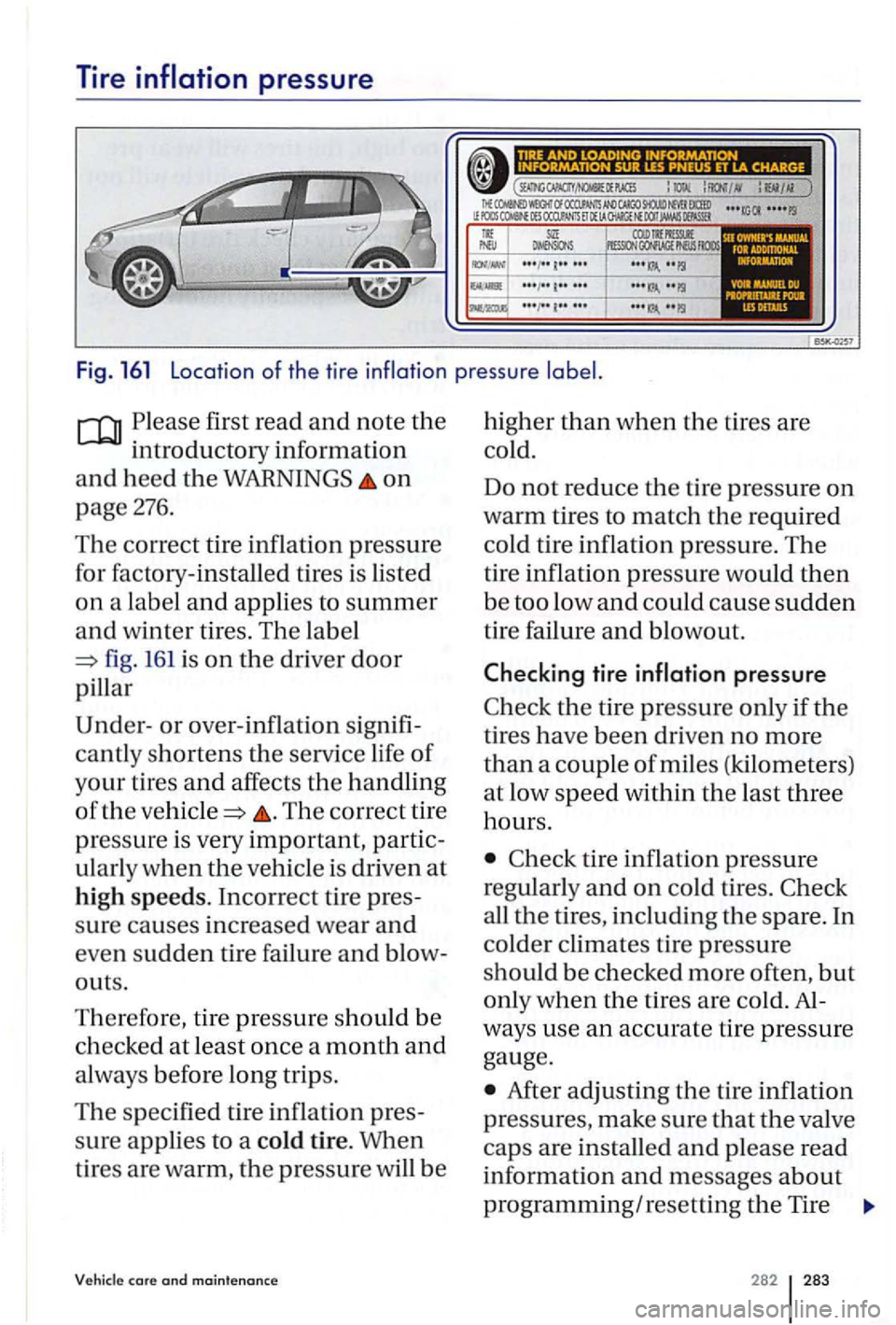
Tire
first read and note the
introduc to ry in
formation
a
nd h ee d the WARNINGS on
page 276.
T he c orr ec t tir e infl atio n
pressure
f o r f ac
tory-install ed tires is lis te d
o n a la b el a
nd a ppli es to summer
and wint er tir es. T he la b el
fig. 161 is on the dri ver door
pillar
Chec k tir e infl ati on pressure
r eg ula
rly a nd on cold tires . C heck
al l
the tir es, includin g th e s pare. In
co l
der clim ates tire pressure
s h ould be c hec k
ed more o ften , but
only w hen th e tir es are c old . Al
w ays use an a cc
urate tir e pressure
ga uge .
Afte r adju stin g tl1e tire inflation
pressures, make sure th at the valve
ca ps a re i
nsta ll ed and please read
informati on and m essages about
programming/rese ttin g th e Tir e
282
Page 285 of 541
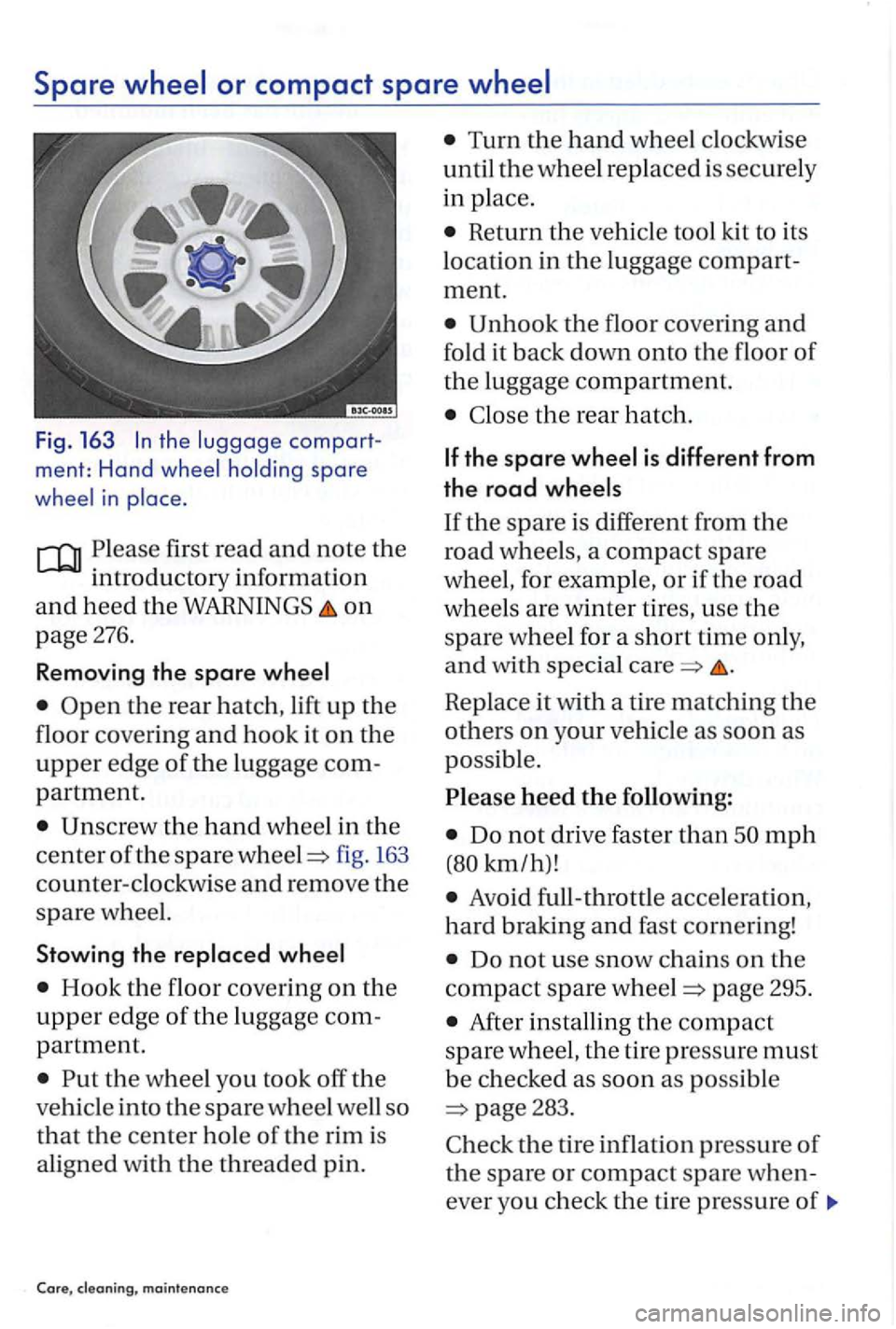
Spare
the compart
ment: Hand
Please first read and note the
introductory information
and heed the WARNINGS on
page 276.
Removing the spare
fig . 163
counter-clockwise and remove the
spare wheel.
Stowing the replaced wheel
Hook the floor cover ing on the
upper edge of the luggage com
partment.
Turn the hand wheel clockwise
until
the wheel replaced is securel y
in place .
Return the vehicle tool kit to its
location in
the luggage compart
ment.
the floor covering and
fold it back down onto the floor of
the luggage compartment.
Close the rear hatch.
Rep lace it with a tire matching the
others on your vehicle as soo n as
poss ible.
Please heed the following:
Do not drive faster than mph
km/h)!
Avoid full-throttle acceleration,
hard braking and fast cornering!
Do not use snow chains on the
compact spare whee l page 295.
After installing the compact
spare wheel, the tire pressure must
b e checked as soon as possib le
283.
Check
the tire inflation pressure of
the spare or compact spare when
ever you ch eck
the tire pressure of
Page 293 of 541
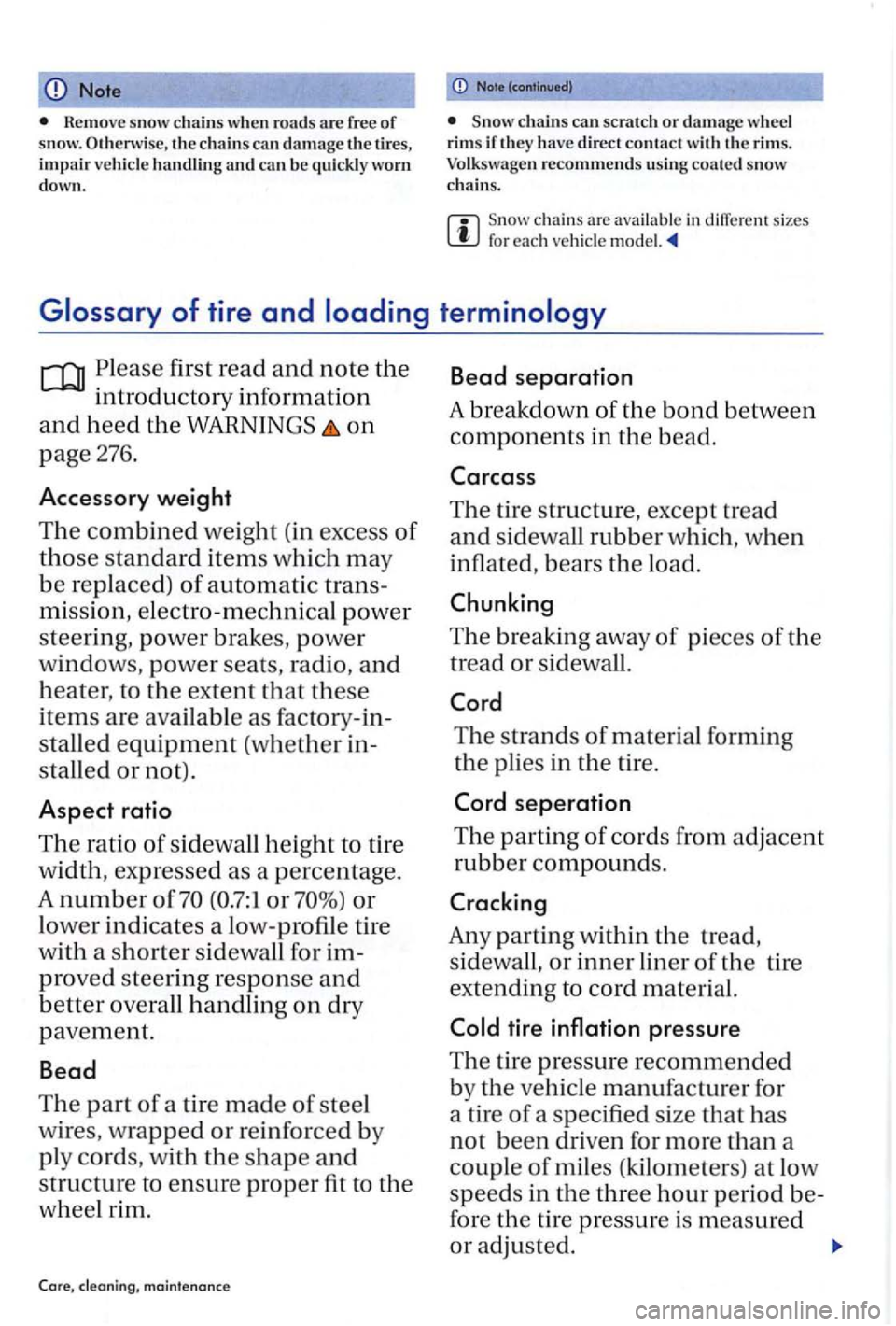
Note
Remove sno w c hain s w hen road s are free or snow. the chains ca n damage tires, impair vehicle handling and ca n be qui ck ly worn
down.
-------chain s they h ave direct contact w ith th e rims. Volk swage n recommend s usin g coa te d sn ow
chains .
c hain s are available in different sizes
Please first read and note the
introductory information
and heed the WARNINGS on
page 276.
Accessory weight
The combine d weight (in excess of
those standa rd items which may
be re placed) of automatic tra n s
mission, electro-mechnical power
stee ring, power brakes, power
windows, power seats, radio, and
heater, to th e extent that these
items are availabl e as factory-in
stall ed equipme n t (w hether in
s tall ed or not).
Aspect ratio
The ratio of sidewall heig h t to tir e
w
idth, expressed as a p ercentage.
A number o r or
lower indicates a low-profile tire
with a shorter sidewall for im
proved steering response and
better overall handling on dry
pavem ent.
Bead
The part of a tire made of steel
wires, wrapped or reinforced b y
ply cords, with the shape and
structure to en sure proper fit to the
w h
eel rim.
maintenance
Bead separation
A breakdown of the bond between
components in the bead.
The tire structure, excep t tread
and s id ewall rubber which, when
infl ate d, bears the lo ad.
The breakjng away of pieces of the
tread or sidewall.
The strands of materia l forming
the plie s in the tir e.
An y parting within the tread,
s id
ewall, or inne r lin er of the tire
ex te
nding to cord material.
at low
speeds in the three hour p e riod be
fore
the tire pressure is measured
o r a
djuste d.